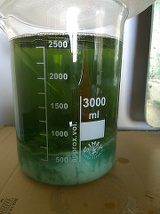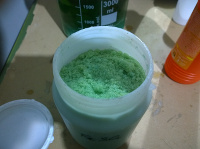The difference I see here is that I make my copperas from scratch, and crystalize the fresh crystals, and store them, before they oxidize, storing the fresh crystals with just a little of their own solution, adding just a little sulfuric acid (a few drops to keep the solution and the crystals acidic) for storage, the fresh crystals sitting in the slightly acidic liquid helps to keep oxygen away from the crystals keeping them fresh and green, just like the copperas crystals shown above from the Wikipedia article.
If you buy good copperas there is no reason to dissolve it, and recrystallize before storage.
If you buy agricultural ferrous sulfate, normally dry crystals, most of them that I have seen are oxidized to white or brownish crystals, and not the bright green crystals we need to precipitate or test for gold with.
The white or brown ferrous sulfate for agricultural use powders or crystals have sit dry and have had fair exposure to oxygen from sitting in the bag, sometimes for long periods of time, and may or may not contain much copperas left in their crystal structure.
I could not find true copperas crystals in my area, every bag sold for agriculture use, I would buy was mainly oxidized iron compounds, not the bright green copperas we need. This is one reason I decided to make my own copperas, and found it an easy process giving me a good product of copperas I could not find locally.
most of the ferrous sulfate I have seen for agriculture use are basically oxidized iron compounds with very little ferrous sulfate left in them, trying to re-dissolve them or adding dilute H2SO4 would give only the ferrous sulfate solution of those crystals that were not oxidized (yet) to some other form of oxidized iron compounds, the oxidized iron would not go into solution easily, I suspect from the pictures you show above much of the copperas you started with was oxidized.
Marcop,
From your first picture of the milky looking solution it looks like much of the iron was oxidized, but from your last picture it looks like you have some good ferrous sulfate in solution (the green solution), and some ferrous sulfate crystals (the bright green crystals), but it also looks like you also have some oxidized iron compound that is not wanted in your solution, (the whitish powder).
This whitish powder is possibly from oxidization of the original ferrous crystal you started with.
You can separate the liquid copperas carefully decanting it from the crystals (green crystals and white powders of un-dissolved oxidized iron compounds), this good green copperas solution can be stored as a liquid in a plastic jug, or recrystallized to bright green copperas crystal if you prefer crystals.
To separate the ferrous sulfate (green crystals) and the oxidized iron compounds (white powders), left after decanting the solution above, you can put the copperas crystals back into solution, on a hot plate in a corning-ware pyro Ceram dish and adding heat, you need to add a little water and a few drops of H2SO4, to dissolve the crystals, the white powder most likely will not dissolve (giving you the milky looking solution), after getting the copperas back into solution, you can filter the solution letting the copperas go through the filter, filtering out the oxidized iron compound, leaving it as white powders or iron powders that may change color on exposure to air, in the filter paper.
You can then store the copperas solution as is, or return the filtered copperas solution to the dish, add heat to evaporate water and recrystallize it into the bright green crystals, storing them as I have described before, you do not use concentrated sulfuric acid, just keeping them a bit acidic is all that is needed, 10% H2SO4 is all that is needed.
















































































